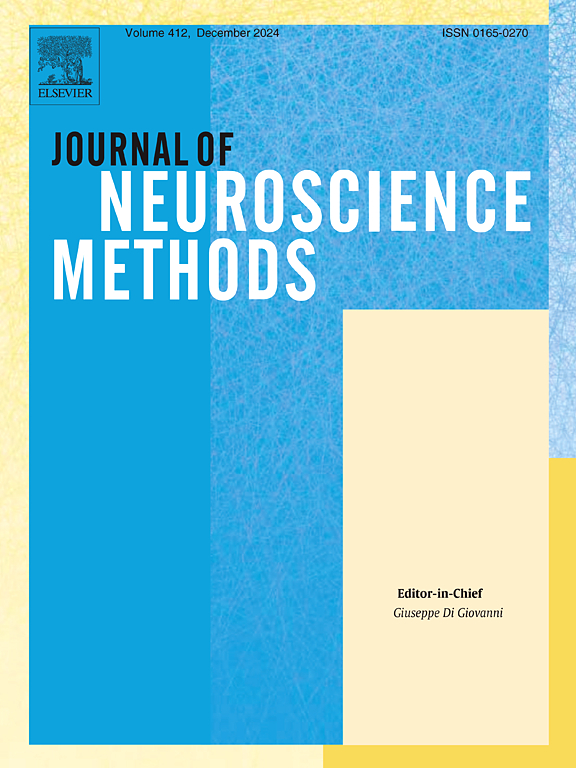Longitudinal EEG-based assessment of neuroplasticity and adaptive responses to transcranial focused ultrasound stimulation
IF 2.7
4区 医学
Q2 BIOCHEMICAL RESEARCH METHODS
引用次数: 0
Abstract
Background
An emerging non-invasive neuromodulation technique named Transcranial-focused ultrasound stimulation (tFUS) offered several advantages than the conventional methods in terms of high spatial precision and penetration depth. In neurological disorders, this emerging method have gained a lot of attention, because of has the potential for therapeutic modulation of brain activity. Then, lack of standardized, Real-Time (RT) assessment protocols will result in unclear comprehension regarding the way the repeated tFUS applications may impacts the neuroplasticity and adaptive brain responses in a long-term. Here, the short-term and long-term neuroplastic modifications were effectively identified by the the longitudinal integration of EEG biomarkers with tFUS stimulation sessions. An adaptive modulation strategies customized for individual neural responses are also facilitated by this hypothesis.
New methods
To integrate the tFUS with high-resolution electroencephalogram (EEG) monitoring in many sessions, Integrated Longitudinal Evaluation Protocol (ILEP) model was suggested in this study. To extract amplitude, latency, spectral dynamics, and connectivity features from evoked potentials, pre-, during-, and post-stimulation EEG signals were identified by the protocol. Then, for monitoring neuroadaptive trajectories over time, the intrgration of the statistical modeling and neural network (NN)-based pattern recognition was employed, and it will assist in analysing those features. For the purpose of differentiating the short-term oscillatory effects from long-term neuroplastic shifts, the following ways will helps in processing the EEG signals: time-frequency decomposition, event-related potential (ERP) analysis, and machine learning (ML) classifiers. Here, the subject-specific response patterns and temporal evolution of brain dynamics were effectively detected by the application of the Deep learning (DL) models.
Results analysis
After the tFUS, both the short-term and long-term modifications in brain activity were effectively detected by the application of ILEP, and it was demonstrated by the outcomes of the simulation and empirical data. Here, the location-specific, session-dependent EEG modifications are consistent with the adaptive neuroplastic processes, and it was revealed by the outcomes of the simulation. Then, accurate neuroadaptive signals were separated from noise and temporary conditions, and it was facilitated by the potential of the model.
Comparison with existing methods
A dynamic, session-over-session monitoring of brain responses was facilitated by the ILEP model. But static images was offered by those conventional methods. With an integration of closed-loop feedback and advanced neural modelling, the suggested model executes better than the conventional methods. This suggested model also facilitates in offering a customized neuromodulation therapies.
Conclusion
For monitoring the neuroplastic modifications induced by tFUS,this suggested ILEP model becomes an effective, sacalable. So, this suggested model facilitates an adaptive assessment model for that tracking, and it was demonstrated in this study. The future, RT, closed-loop neuromodulation systems in therapeutic and cognitive enhancement contexts may get benefits from the integration of EEG feedback mechanisms in the suggested model.
经颅聚焦超声刺激下神经可塑性和适应性反应的纵向脑电图评估
经颅聚焦超声刺激(Transcranial-focused ultrasound stimulation, tFUS)是一种新兴的无创神经调节技术,具有空间精度高、穿透深度高等优点。在神经系统疾病中,这种新兴的方法已经获得了很多关注,因为它具有治疗脑活动调节的潜力。然后,缺乏标准化的实时(RT)评估协议将导致对反复使用tFUS的方式在长期内可能影响神经可塑性和适应性大脑反应的理解不清。通过脑电图生物标志物与tFUS刺激的纵向整合,有效地识别了短期和长期的神经可塑性改变。这一假设也促进了为个体神经反应定制的自适应调制策略。为了将tFUS与多时段高分辨率脑电图(EEG)监测结合起来,本研究提出了综合纵向评估方案(ILEP)模型。为了从诱发电位中提取振幅、潜伏期、频谱动力学和连通性特征,通过该方案识别刺激前、刺激中和刺激后的脑电图信号。然后,为了监测神经自适应轨迹随时间的变化,采用了统计建模和基于神经网络(NN)的模式识别的集成,并将有助于分析这些特征。为了区分短期振荡效应和长期神经可塑性变化,以下方法将有助于处理脑电图信号:时频分解、事件相关电位(ERP)分析和机器学习(ML)分类器。本研究通过深度学习模型的应用,有效地检测了受试者特定的反应模式和大脑动力学的时间演变。结果分析:在tFUS后,ILEP的应用有效地检测了短期和长期脑活动的变化,并通过模拟结果和经验数据证明了这一点。在这里,位置特异性、会话依赖性的脑电图修改与自适应神经塑性过程一致,这一点在模拟结果中得到了揭示。然后,将准确的神经适应信号从噪声和临时条件中分离出来,并利用模型的潜力来促进。与现有方法相比,ILEP模型更易于对大脑反应进行动态、会话间的监测。但是这些传统方法只能提供静态图像。该模型将闭环反馈与先进的神经模型相结合,比传统方法具有更好的执行效果。这个建议的模型也有助于提供定制的神经调节疗法。结论为监测tFUS所致的神经可塑性改变,ILEP模型是一种有效的、可推广的模型。因此,这个建议的模型促进了跟踪的适应性评估模型,并且在本研究中得到了证明。未来,在治疗和认知增强环境下的RT、闭环神经调节系统可能会受益于EEG反馈机制在该模型中的整合。
本文章由计算机程序翻译,如有差异,请以英文原文为准。
求助全文
约1分钟内获得全文
求助全文
来源期刊

Journal of Neuroscience Methods
医学-神经科学
CiteScore
7.10
自引率
3.30%
发文量
226
审稿时长
52 days
期刊介绍:
The Journal of Neuroscience Methods publishes papers that describe new methods that are specifically for neuroscience research conducted in invertebrates, vertebrates or in man. Major methodological improvements or important refinements of established neuroscience methods are also considered for publication. The Journal''s Scope includes all aspects of contemporary neuroscience research, including anatomical, behavioural, biochemical, cellular, computational, molecular, invasive and non-invasive imaging, optogenetic, and physiological research investigations.
 求助内容:
求助内容: 应助结果提醒方式:
应助结果提醒方式:


